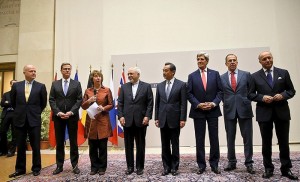 Ronald Reagan�s famous dictum on dealing with the Soviet Union was to �trust, but verify�.
Ronald Reagan�s famous dictum on dealing with the Soviet Union was to �trust, but verify�.But according to the US Senator John McCain earlier this month, in the case of�Iran, US policy must be: �don�t trust, and verify.�
On Tuesday, diplomats from the P5+1 powers � the permanent members of the security council and Germany � gather in Vienna to open comprehensive negotiations over Iran�s nuclear programme.
Mr McCain�s widely shared scepticism speaks to the diplomatic gulf the talks seek to bridge � and, perhaps indirectly, to the greatest impediment in trying to do so: The White House not only needs to build trust with Iran, but on Capitol Hill, too. Likewise, president Hassan Rouhani must�find a solution he can sell in Tehran�� and not just to those who helped elect him.
Diplomats and analysts agree that a final deal to�cap November�s landmark interim agreement�is technically do-able, but few are under any illusions as to the obstacles in its way.
�I agree with president Obama � a 50 per cent chance of succeeding is about right,� says Sir Richard Dalton, the UK�s former ambassador to Iran, now a fellow at Chatham House, the think-tank. �It is possible. The [November agreement] pointed the way to success .?.?. but hardliners in Washington and Tehran are going to be hard to satisfy.�
The Vienna Negotiations will focus on three key issues.
First and foremost will be the allowable level of future uranium enrichment. Second the issue of Iran�s reactor at Arak and its future; and third the so-called �possible military dimensions�, or PMDs.
P5+1 negotiators will open discussions with a request for Iran to lay out exactly what level of enrichment it feels it needs � and why. From there they will seek to work back to a common position, diplomatic sources say.
While Iran�s�fiercest regional critics are uncompromising�� Israeli intelligence officials repeat only one number on the subject of enrichment: zero � diplomats in the P5+1 recognise that some enrichment must be allowed.
�The only red lines I like are the ones on my pyjamas,� said one European official. A deal in which Iran gave up its nuclear capability entirely � or even a large chunk of it � is �unachievable� says another.
The P5+1 have other firm requirements, including demands for greater transparency and surveillance of nuclear sites in Iran. The more credibly transparent Iran is, the more flexibility there will be on enrichment.
Crucial to the enrichment discussions will be Iran�s �breakout� time � the period it would take to amass enough enriched uranium for a bomb. The capability is determined both by the size of Iran�s existing stockpile and the sophistication � as well as the number � of its centrifuges.
Although Mr Rouhani has said Iran will not destroy its centrifuge cascades ���100 per cent [no]��he told the FT in November � analysts point to potential options that could leave both sides satisfied.
�I can see many compromises in which Iran makes a large number of its centrifuges inoperable, but does so in a way that allows it to sustain Rouhani�s claim that he won�t �dismantle� centrifuges,� says Shashank Joshi, research fellow at the Royal United Services Institute, the British independent defence and security think-tank.
The question of the Arak heavy water reactor too, appears surmountable, says Mr Joshi.
Last week, the head of Iran�s Atomic Energy Organisation, Ali Akbar Salehi said the country might be prepared to �make changes� to the Arak reactor even though he believed fears over its function to be unfounded.
A big concession likely to be demanded by the P5+1 ��particularly by France�� will be the conversion of the reactor into a light water design which would produce far less material capable of being refined into plutonium.
The third area of negotiation, PMDs, however, is the most difficult to gauge, and could potentially scupper a final agreement.
Iran still denies its nuclear programme has any military purpose, but since 2002, the International Atomic Energy Authority, based on evidence from member states� intelligence agencies, has compiled a�list of suspected projects�that indicate otherwise.
Among them: projects to acquire or design high-tech detonators and neutron sources necessary to explode atomic weapons; research into new, special spherical payloads for Shahab ballistic missiles; and modelling work and �hydrodynamic experiments� aimed at perfecting implosion devices.
Diplomats see some glimmers of hope. Last week Iran agreed for the first time�to address a PMD issue�raised by the IAEA � that of exploding bridge-wire detonators, commonly used in nuclear weapons.
All of which is not to say that four months � the time left until the six-month period of sanctions relief struck in November�s interim deal expires � will be enough to do a final deal. Few seem to believe it is achievable in that timeframe.
And yet, with hawks in Washington and Tehran poised, timing could well prove to be what matters most of all.
By The Financial Times�
The Iran Project is not responsible for the content of quoted articles.










